Many guitarists, especially beginners, wonder if they are holding their guitar pick correctly. It might seem like a minor detail, but the way you grip your pick can significantly impact your tone, speed, and overall playing comfort. Even experienced players sometimes revisit this fundamental technique to refine their sound. So, if you’re questioning your pick grip, you’re definitely not alone, and it’s absolutely not a stupid question!
Let’s explore the most common and effective ways to hold a guitar pick, helping you discover what works best for your playing style and musical goals.
Exploring the Three Main Guitar Pick Grips
While personal variations exist, there are three primary methods for holding a guitar pick that most players utilize. Understanding these techniques is the first step in finding your ideal grip.
1. The “O” Method: Balancing Control and Tone
Often considered the most versatile and commonly taught method, the “O” grip provides a balanced approach to control and tone. This technique involves forming an elongated “O” shape with your thumb and index finger. The pick is held between the side of your index finger and the pad of your thumb.
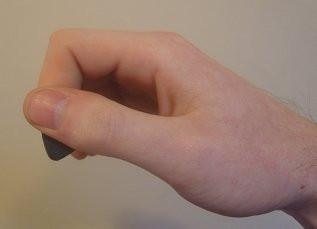 Image alt: Close-up showing the “O” method of holding a guitar pick, demonstrating the elongated O shape formed by the thumb and index finger.
Image alt: Close-up showing the “O” method of holding a guitar pick, demonstrating the elongated O shape formed by the thumb and index finger.
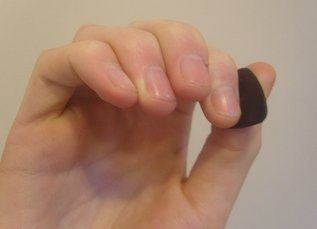 Image alt: Another angle of the “O” guitar pick grip, highlighting the thumb and index finger position and the pick placement.
Image alt: Another angle of the “O” guitar pick grip, highlighting the thumb and index finger position and the pick placement.
Why the “O” Method Works:
- Versatility: Suitable for various genres and techniques, from strumming chords to playing lead lines.
- Control: Offers a good balance of control over pick depth and angle, allowing for nuanced playing.
- Tone: Produces a clear and articulate tone, adaptable to different musical styles.
This method is an excellent starting point for beginners and remains a reliable choice for experienced players seeking a flexible and controlled pick grip.
2. The “Pinch” Method: For Strumming and Flexibility
The “pinch” method emphasizes flexibility and is often favored by guitarists who primarily strum chords, especially with lighter gauge picks. In this grip, the pick is held between the flat of your index finger and your thumb, creating a more flexible hold.
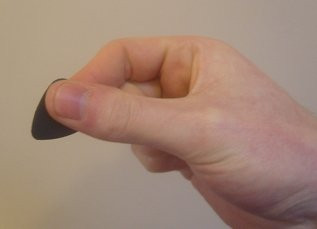 Image alt: Demonstration of the “pinch” guitar pick grip, focusing on the flat of the index finger pressing against the pick.
Image alt: Demonstration of the “pinch” guitar pick grip, focusing on the flat of the index finger pressing against the pick.
 Image alt: A different perspective of the “pinch” pick holding method, showing the thumb and flat index finger creating a flexible grip.
Image alt: A different perspective of the “pinch” pick holding method, showing the thumb and flat index finger creating a flexible grip.
Advantages of the “Pinch” Method:
- Flexibility: Allows for greater pick flexibility, ideal for strumming rhythmic patterns.
- Smoothness: Facilitates smooth and fluid strumming, particularly for rhythm guitar playing.
- Light Gauge Picks: Complements lighter gauge picks, enhancing strumming articulation.
While excellent for strumming, the “pinch” method might offer less control for intricate lead work compared to the “O” method.
3. The “Fist” Method: Power and Heavier Picks
The “fist” method, sometimes called the “parallel” method, is often adopted by players who prefer heavier gauge picks and desire a powerful, robust tone. Bluegrass guitarists, known for their strong picking style, frequently utilize this grip. Here, the index finger is curled more directly parallel under the thumb, creating a firmer hold.
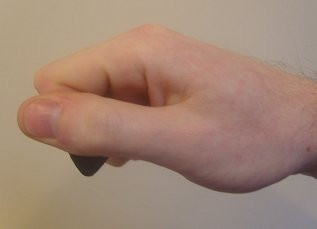 Image alt: The “fist” or parallel guitar pick grip illustrated, showing the index finger curled parallel under the thumb for a firm hold.
Image alt: The “fist” or parallel guitar pick grip illustrated, showing the index finger curled parallel under the thumb for a firm hold.
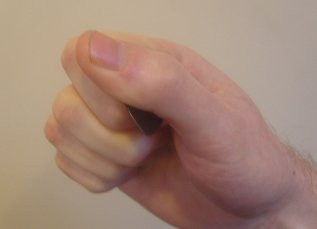 Image alt: Another view of the “fist” pick grip, emphasizing the thumb and curled index finger position and the resulting firm pick hold.
Image alt: Another view of the “fist” pick grip, emphasizing the thumb and curled index finger position and the resulting firm pick hold.
Benefits of the “Fist” Method:
- Power: Provides a strong and direct attack, resulting in a louder and more powerful tone.
- Heavy Gauge Picks: Works well with heavier gauge picks, maximizing their tonal potential.
- Aggressive Styles: Suits genres and techniques that require a more aggressive and forceful picking approach.
While powerful, the “fist” method can sometimes feel less nuanced for delicate playing styles and might require practice to achieve smooth rhythm playing.
Finding Your Ideal Guitar Pick Grip
Ultimately, the “correct” way to hold a guitar pick is the way that feels most comfortable and allows you to achieve your desired sound and playing style. Experimentation is key to discovering your personal preference.
Factors to Consider:
- Pick Gauge: Lighter picks often pair well with more flexible grips like the “pinch” method, while heavier picks can benefit from firmer grips like the “fist” method. The “O” method is versatile enough to work with a wide range of pick gauges.
- Musical Style: Your preferred genre will influence your ideal grip. Strumming-heavy styles might favor the “pinch” method, while genres requiring powerful single-note lines could benefit from the “fist” or “O” method.
- Personal Comfort: The grip should feel natural and comfortable in your hand, allowing for relaxed and fluid playing over extended periods.
Experimentation Tips:
- Try Each Method: Spend time practicing each of the three main methods to get a feel for their nuances and how they impact your playing.
- Vary Pick Gauges: Experiment with different pick thicknesses while using each grip to see how they interact.
- Play Different Styles: Practice strumming, single-note lines, and different musical genres to assess each grip’s versatility.
- Don’t Overthink It: While experimentation is valuable, avoid constantly switching grips. Once you find a comfortable and effective method, stick with it and allow your muscle memory to develop.
The Best Grip is the One That Works For You
There’s no single “best” way to hold a guitar pick. Many legendary guitarists use variations of these methods, and some even develop their own unique grips. The key is to understand the fundamentals, experiment with different techniques, and ultimately choose the grip that empowers you to play comfortably, expressively, and achieve your musical goals. So, explore these techniques, trust your instincts, and enjoy the journey of finding your perfect pick grip!

